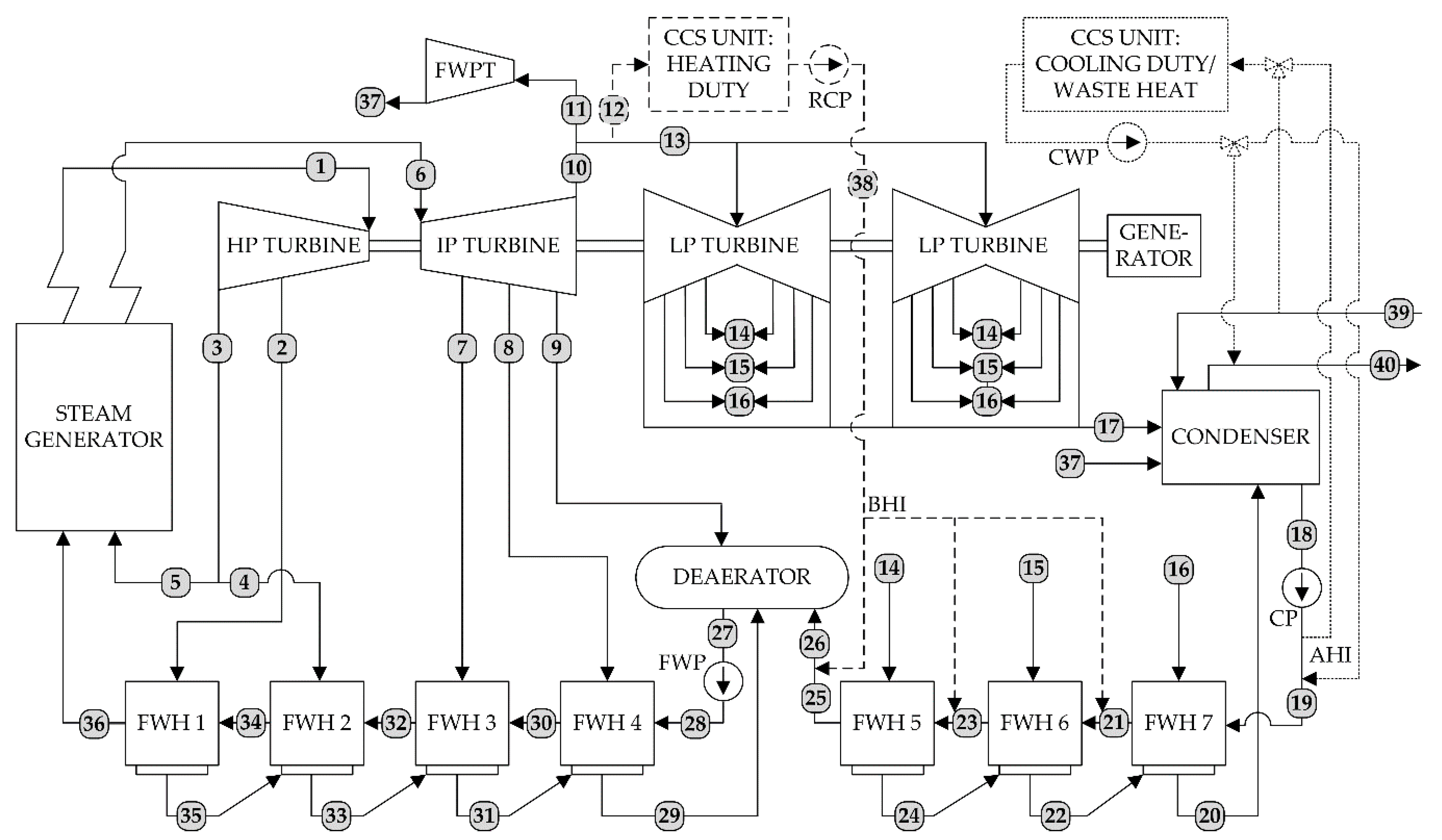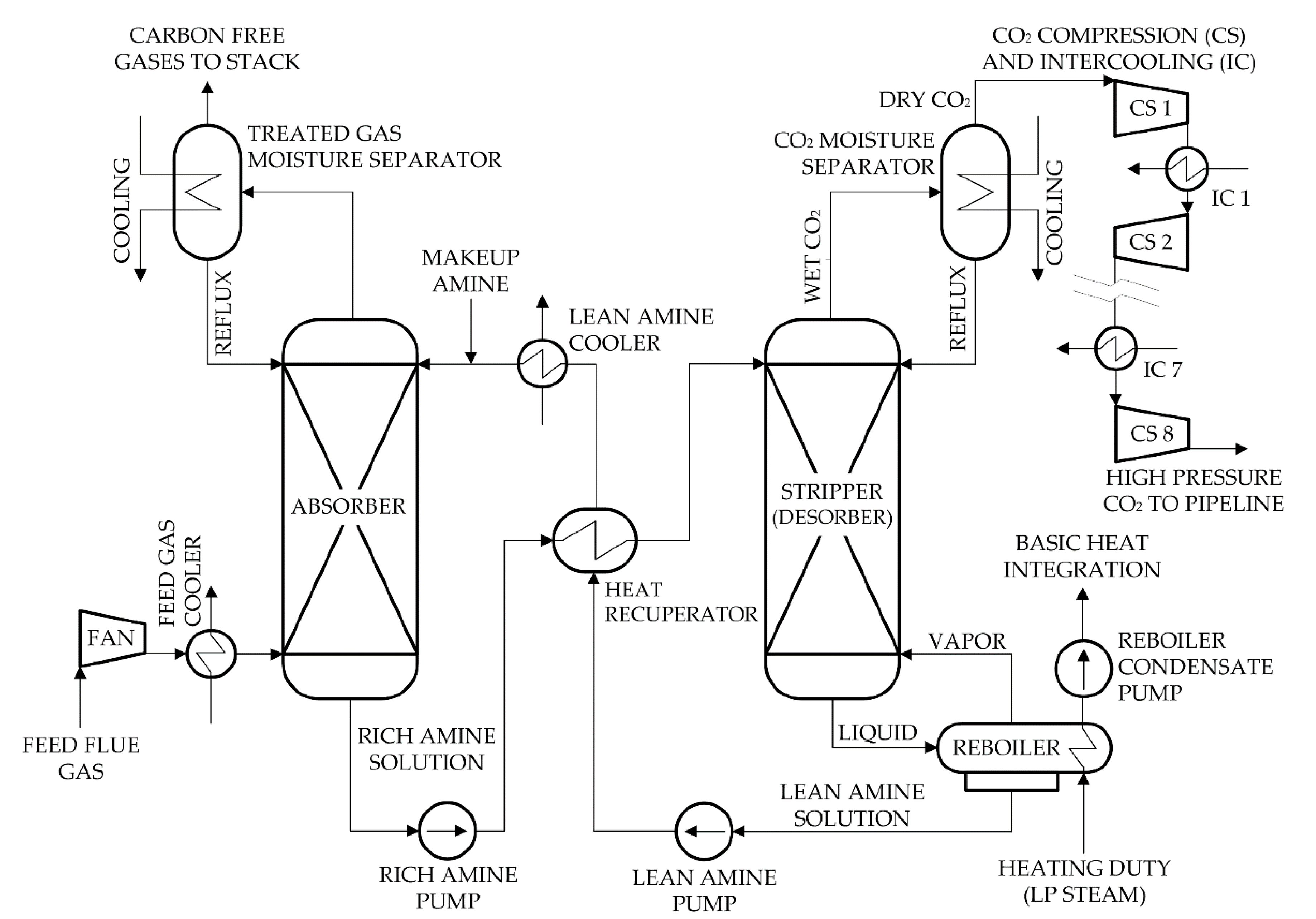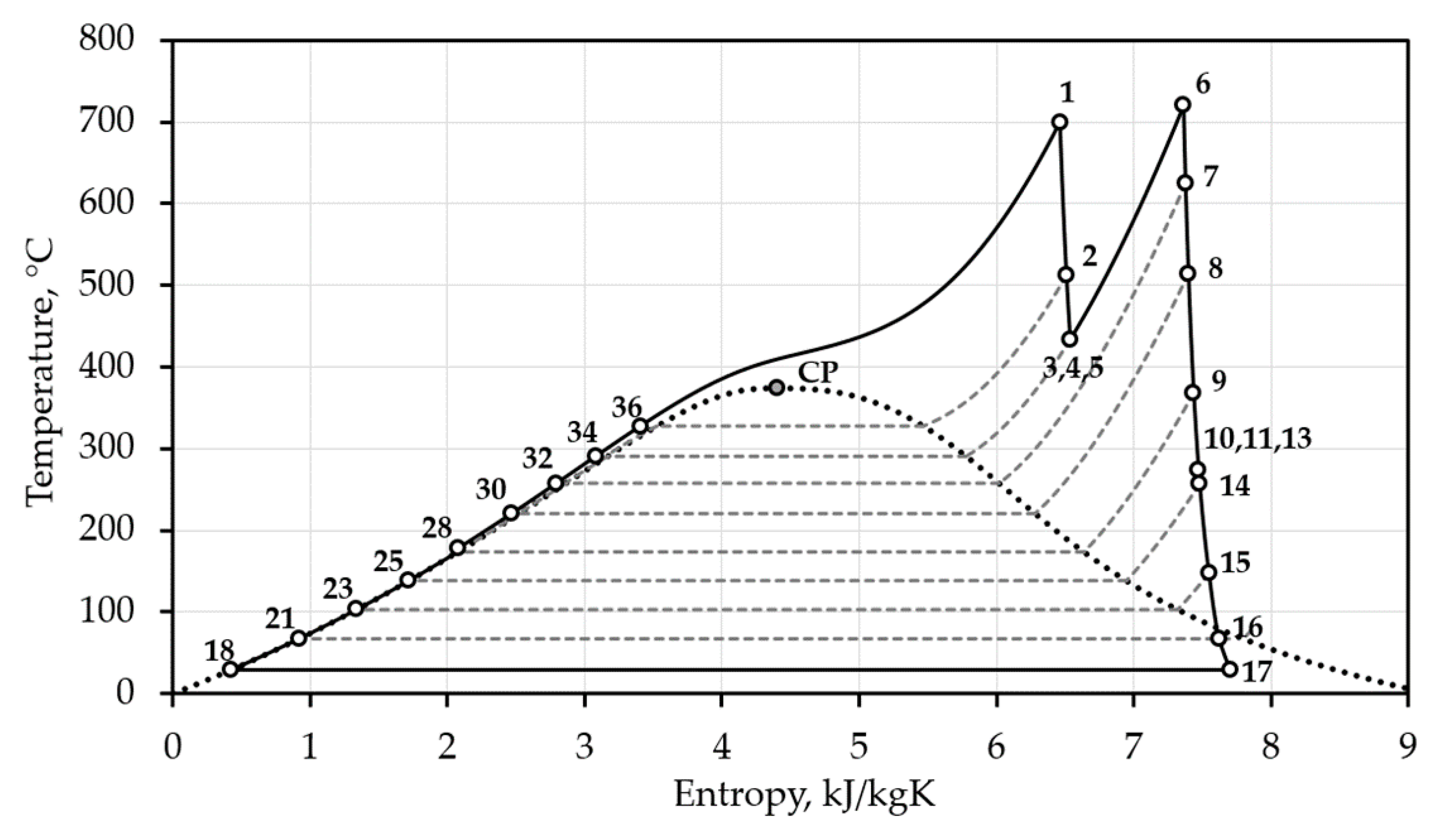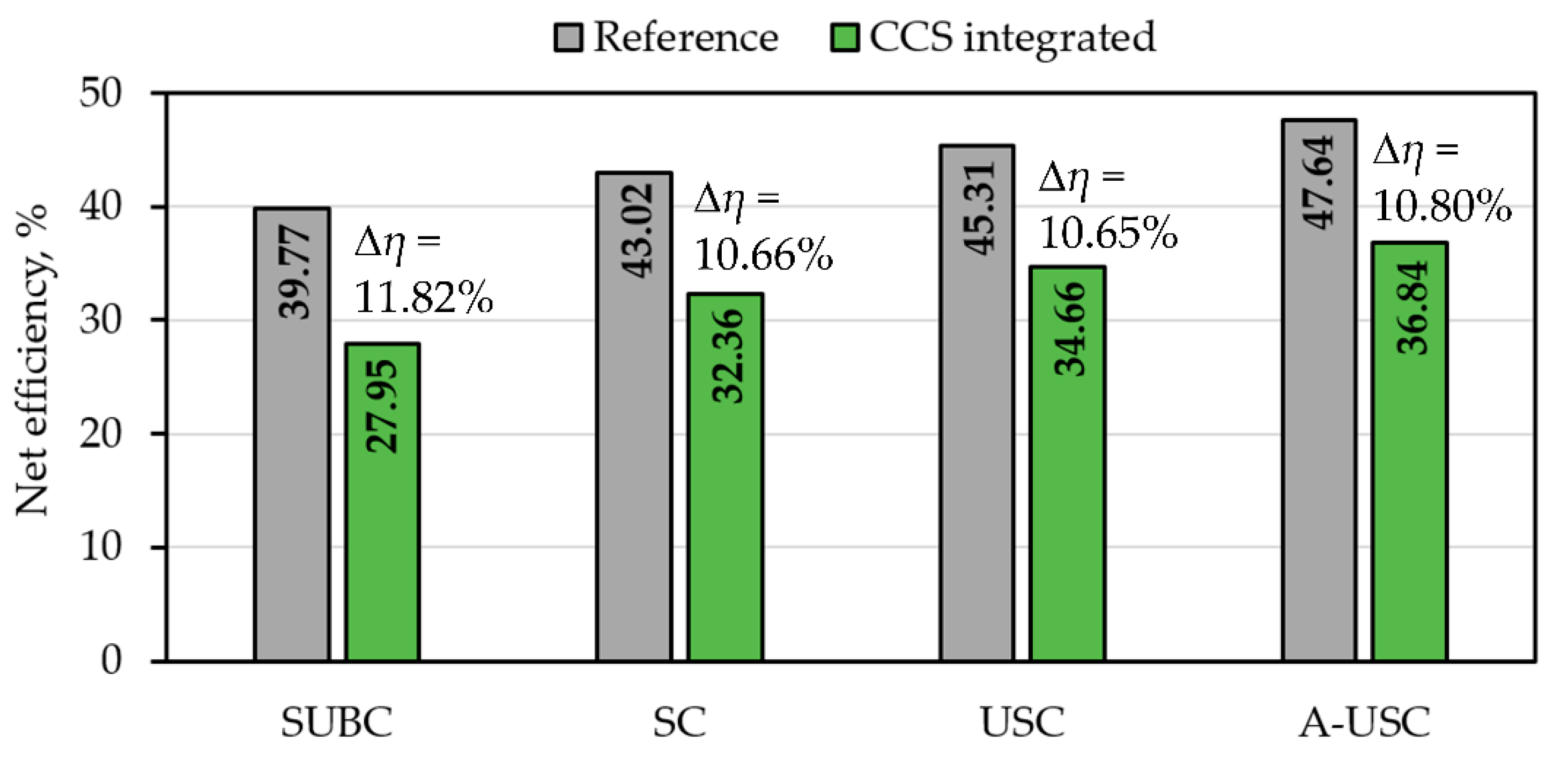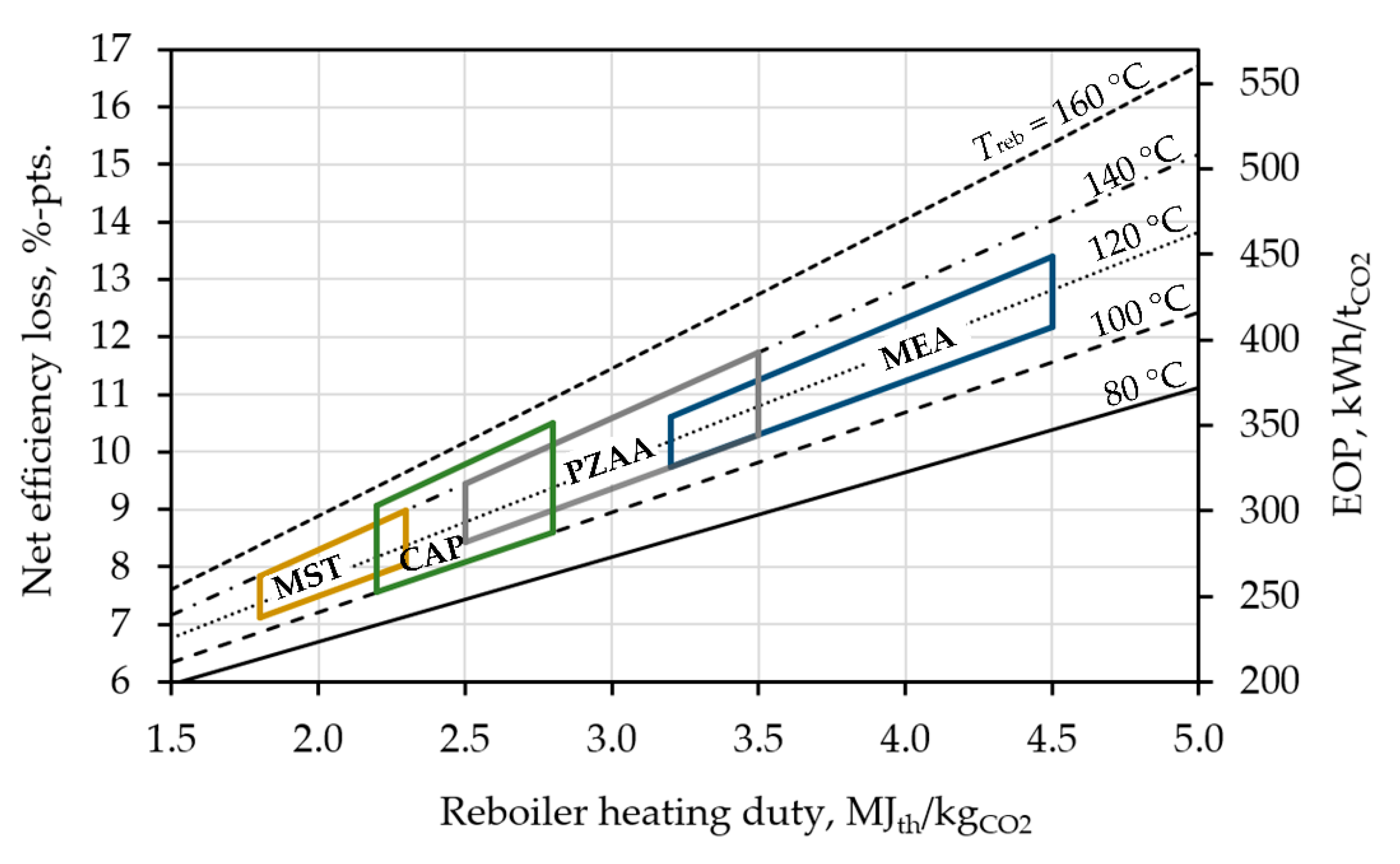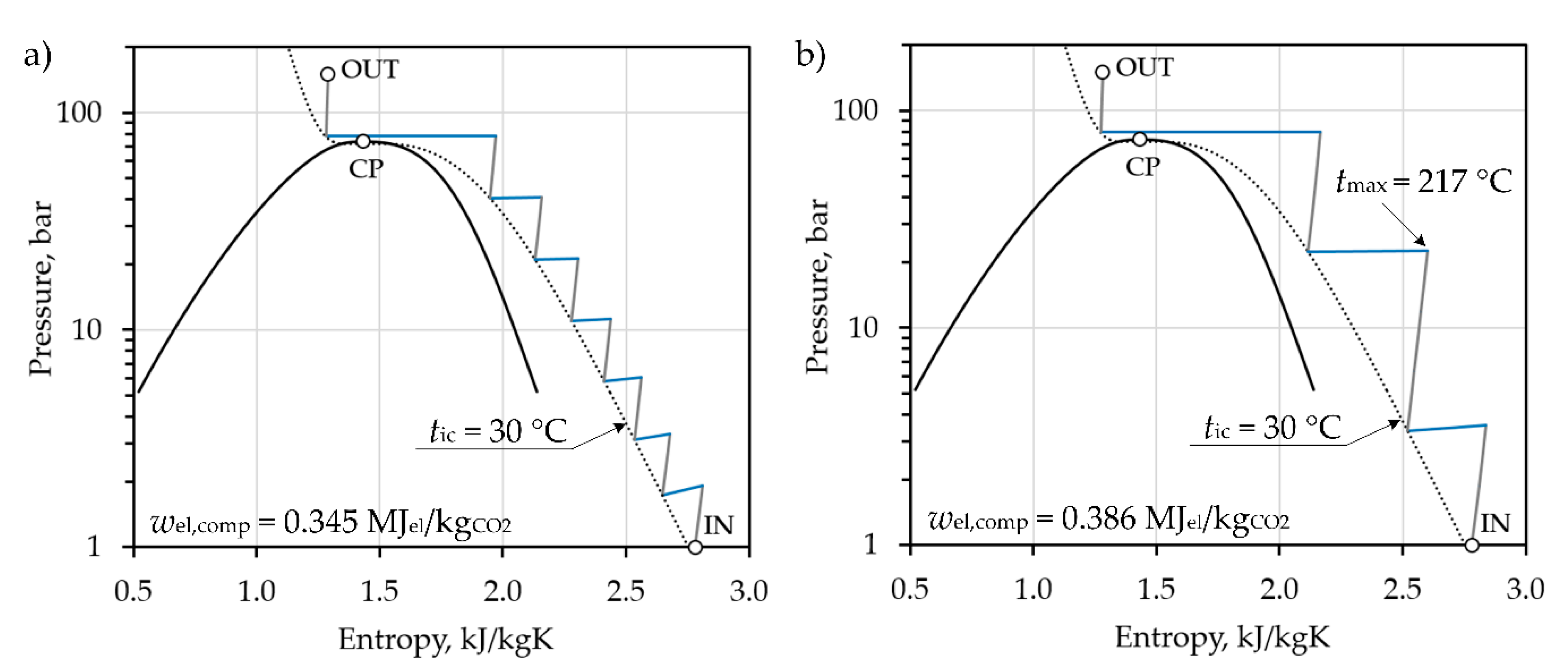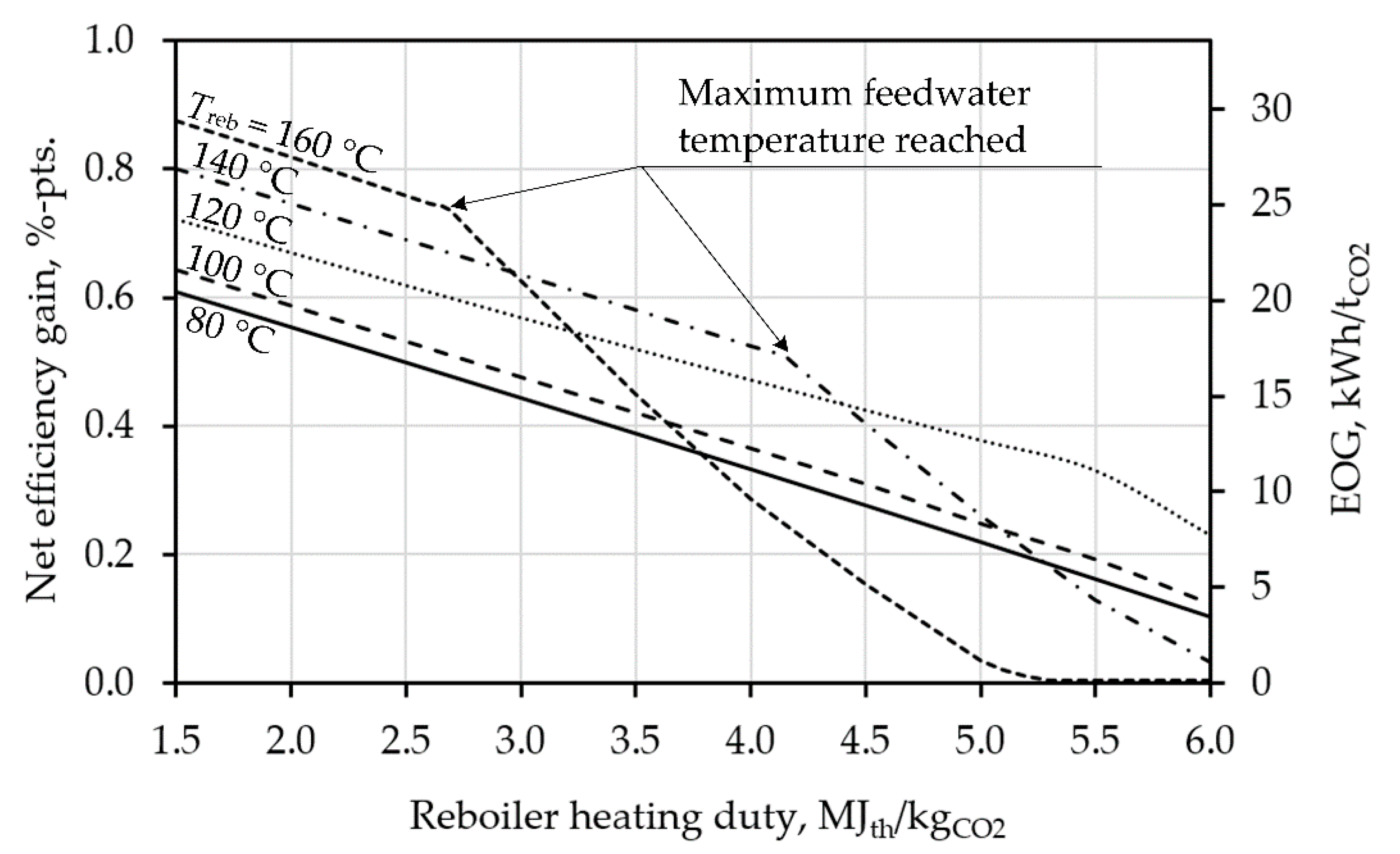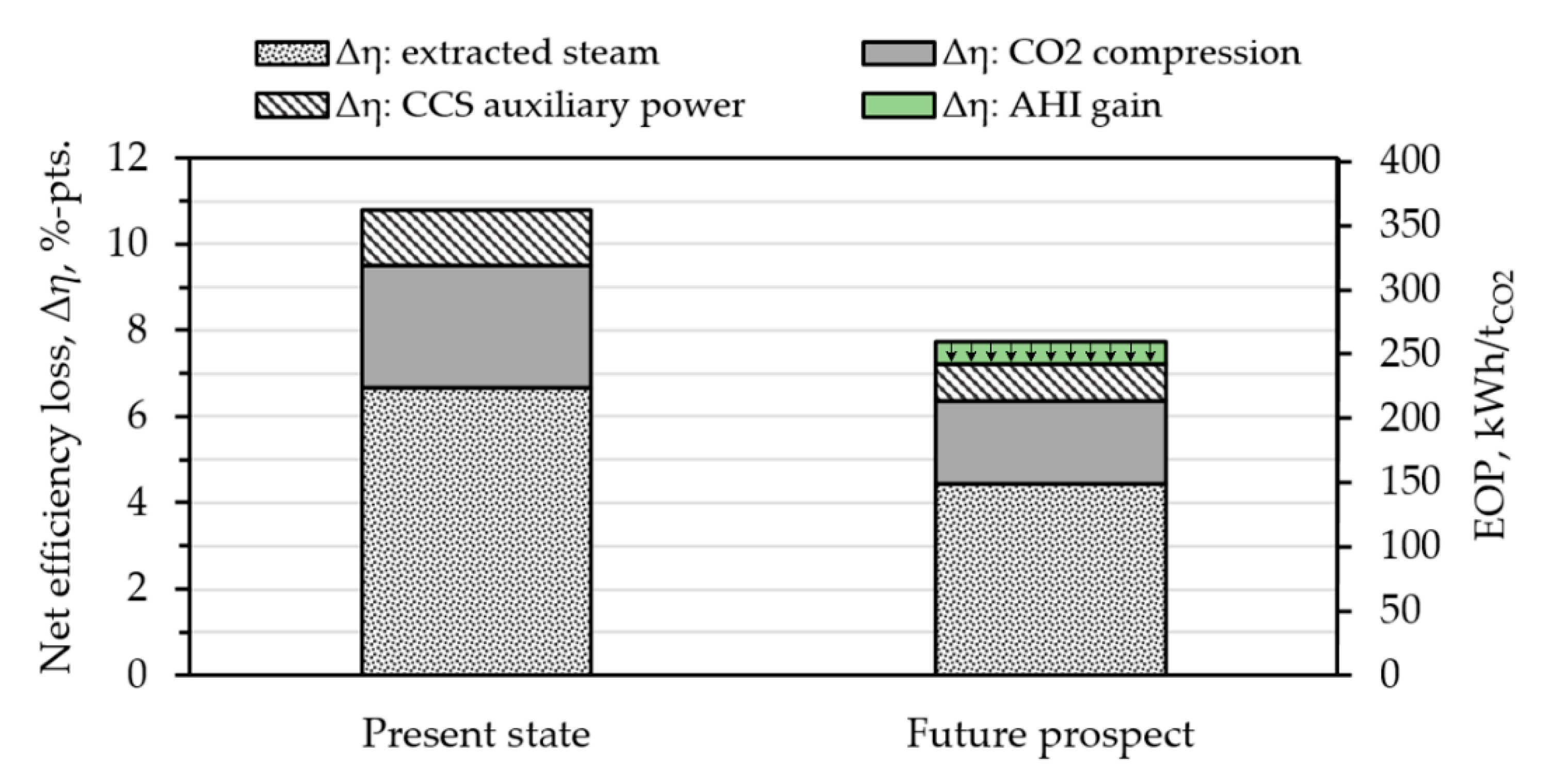1. Introduction
Nowadays, fossil fuels are still the backbone of power generation. In 2019, fossil fuels generated 62.7% of the total global electricity [
1]. By energy source, coal contributes with 36.4% in the total electricity generation [
1]. Due to pressing environmental and climate concerns, decarbonization of the electric power industry has become imperative. The IEA scenarios in the 2020 World Energy Outlook predicts the reduction of CO
2 emissions from the power industry by as much as 60% between 2020 and 2030 [
2]. Three-fourths of this reduction will be achieved from the rapid decline of conventional coal-fired generation. However, the share of advanced supercritical coal power plants is expected to rise in order to meet the ongoing growth in global electricity demand [
3]. Supercritical steam cycles paired to carbon capture and storage (CCS) technologies are going to be integrated into future clean coal power plants [
4]. By 2030, most of the advanced coal power plants will be upgraded with carbon capture, utilization, and storage (CCUS) technologies.
Subcritical power plants (SUBC) achieve thermal efficiency in the range between 34% and 40% (based on coal LHV) with the global average efficiency around 36%, whereas modern supercritical power plants (SC) reach efficiencies between 42% and 45% [
5]. Ultra-supercritical power plants (USC) employ advanced metal alloys to withstand extreme steam conditions and achieve even higher efficiencies. A record-high net efficiency of 47.5% was achieved by the RDK Block 8 unit in Germany [
6]. This is due to the elevated steam conditions: Superheat and reheat steam temperatures of 600/620 °C and steam pressures of up to 275 bar. Advanced ultra-supercritical power plants (A-USC) are expected to enter operation in the next decade and will approach 50% net electricity generation efficiency [
7] with the use of advanced metal alloys capable of withstanding steam temperatures and pressures over 700 °C and 350 bar [
8,
9]. These advanced alloys (superalloys) are being developed by adding chromium (Cr), nickel (Ni), cobalt (Co), vanadium (V), wolfram (W), and molybdenum (Mo) to ferritic steels to obtain higher temperature- and corrosion-resistance [
5,
8].
Increased thermal efficiency leads to reduced emissions of greenhouse gases and pollutants. To put it into perspective, replacing an old conventional subcritical power plant with a new supercritical corresponds to a 10% efficiency gain and a CO
2 emission reduction of more than 20%. For example, a conventional coal-fired power plant generates electricity at 36% thermal efficiency while having specific emissions of around 1000 kg
CO2/MWh
el. An USC unit with 46% thermal efficiency generates 28% (0.46/0.36 = 1.28) more electricity per unit of fuel heat input than the subcritical unit, whereas the emissions are 781 kg
CO2/MWh
el (1000/1.28 = 781), a 21.9% reduction. A-USC coal power plants could achieve even lower CO
2 emissions, around 700 kg/MWh [
10]. Further CO
2 emission reductions, down to 100 kg/MWh, would be possible only with the implementation of post-combustion carbon capture and storage (CCS) for the treatment of flue gases released during fossil fuel combustion.
The Global Status of CCS 2020 [
11] reports 26 commercial CCS facilities currently in operation with a total capture and storage capacity of 40.7 million tonnes of CO
2 per year (Mtpa). CCS units are being used in the following industries: Natural gas processing (30.5 Mtpa), power generation (2.4 Mtpa), hydrogen production (2.2 Mtpa), fertilizer production (1.8 Mtpa), methanol and ethanol production (1.6 Mtpa), oil refining (1.4 Mtpa), iron and steel production (0.8 Mtpa). At present, two capture demonstration projects are up and running in the power generation sector: The Boundary Dam power plant and the Petra Nova power plant [
12]. Both are using amine-based post-combustion capture, applied on one coal-fired unit each, and the captured carbon is transported via pipelines to enhanced oil recovery fields. Enhanced oil recovery (30.7 Mtpa) and storage in dedicated geological formations (10 Mtpa) are the two types of carbon storages used in these industries. By 2050, the CCS sector is envisioned to grow to a total global installed capacity of 5600 Mtpa of CO
2 [
11].
The estimated costs of CCS projects for fossil fuel power plants span over wide ranges of values, as reported in the relevant literature [
13,
14]. The costs of CCS depend on the fuel type, the costs of labor, materials, operation and maintenance, the carbon capture technology, the costs of transport and storage, and the type of project (greenfield or retrofit). The levelized cost of electricity (LCOE) is between 61 and 87 US
$/MWh in power plants without CCS and between 94 and 163 US
$/MWh for power plants with CCS [
13,
14]. The LCOE could be reduced to between 61 and 139 US
$/MWh when the captured CO
2 is sold to enhanced oil recovery projects instead of simply storing it in geological formations. The cost of captured CO
2 is between 33 and 58 US
$/t
CO2, while the cost of avoided CO
2 (including compression, transport, and storage) is between 44 and 86 US
$/t
CO2 [
13,
14]. Post-combustion CCS for combined cycle natural gas turbines (CCGT) or SCPC power plants with oxy-fuel combustion are predicted to operate with similar costs. Slightly higher costs were estimated for coal-based integrated gasification combined cycles (IGCC) with pre-combustion CCS [
14]. The specific costs of CO
2 transport are between 2 and 15 US
$/t
CO2, depending on the pipeline capacity, type (onshore or offshore), and length [
14,
15]. The specific costs of CO
2 storage are estimated between 1 and 18 US
$/t
CO2, depending on the storage type (depleted oil/gas field, geological formation, or ocean storage) and the potential of using EOR credits. The worldwide CO
2 storage capacity is 400 billion tonnes in discovered capacities in oil and gas fields (depleted or for EOR projects) and 12,000 billion tonnes in potential (estimated) storage capacities in geological (saline) formations [
16]. The CO
2 storage capacities are such that exceeds the global net-zero emission scenario. It is estimated that the CCS industry would be cost-effective with carbon prices between 40 and 80 US
$/tCO
2 [
11].
CCS technology offers vast potentials for CO
2 reduction in the power industry, in the cement, iron, and steel production industries, and in the oil, natural gas, and chemical processing industries [
17]. Different countries are developing their own legal and technical frameworks for future large-scale CCS implementation. Lee et al. [
18,
19] stressed the importance of developing reliable methodologies for quantifying CO
2 emission reduction through CCS at national basis. Nasirov et al. [
20] analyzed decarbonization possibilities in developing countries and concluded that wind and solar energy are future of electricity generation, but still 15% of the electricity will be from coal by 2050. Kumar Shukla et al. [
21] reviewed the clean coal potentials for the power industry in India. They concluded that post-combustion CCS is the solution for achieving a 30% CO
2 emission reduction by 2030 in India. Yun et al. [
22] analyzed four scenarios for the power industry in South Korea. They concluded that the CCS coal scenario offers a good perspective in terms of greenhouse gases emissions control and electricity prices. Markewitz et al. [
23] studied the potential of CCS technology for the cement industry, which contributes 5% of the global CO
2 emissions. They concluded that CCS can remove 70–90% of the CO
2 emissions from the cement industry in Germany at avoidance costs between 77 and 115 EUR/t
CO2. Toktarova et al. [
24] analyzed different pathways for the decarbonization of the steel industry in Sweden. They showed that top gas recycling blast furnaces and electric arc furnaces fitted with CCS technology could reduce CO
2 emissions by 83% in 2045. Adu et al. [
25] studied the CO
2 avoidance costs for post-combustion CCS technology integrated in coal-fired and natural gas combined cycle power plants. They concluded that, at 90% CO
2 capture efficiency, the CO
2 avoidance costs are
$72/tCO
2 for the coal-fired plant and
$94/tCO
2 for the natural gas combined cycle.
CCS is an energy-intensive technology affecting substantially the plant performance. In coal-fired power plants, previous studies have reported net efficiency losses in the range between 7 and 11%-pts [
26,
27,
28] and electricity output penalties between 300 and 400 kWh/t
CO2 [
29]. Vu et al. [
26] compared the techno-economical aspects of carbon capture on USC steam cycles with air-combustion and oxy-fuel combustion. They concluded that oxy-fuel CCS power plants offer an advantage over air-combustion CCS power plants. The net efficiency loss and levelized cost of electricity was 7%-pts and
$59/MWh in the first case, whereas 10%-pts and
$64/MWh in the second case. Liebenthal et al. [
27] estimated the net efficiency loss at 10.94%-pts for a CCS retrofit project on a supercritical power plant achieving 45.5% net efficiency at the design point. Li and Liang [
30] assessed a CCS retrofit project for an existing USC power plant with 1000 MW capacity and estimated the efficiency loss at 8.6%-pts for 90% capture rate and 6%-pts for a 50% capture rate. Xu et al. [
31] estimated that modified boiler structures, waste heat recovery, and steam bleed turbines could be used to reduce the efficiency loss from 12.65% down to 8.79%-pts Jackson and Brodal [
32] found that the efficiency loss can be reduced through the optimization of the CCS compression process. Compressor designs with multiple impellers per stage and variable pressure ratios are proposed.
The previous research is mainly focused on the performance analysis of CCS retrofit projects for coal-fired power plants. The present study makes a step forward by assessing the impact of CCS technology on four different generations of coal-fired power plants including the subcritical (SUBC), the supercritical (SC), the ultra-supercritical (USC), and the advanced ultra-supercritical (A-USC) steam cycle using performance simulation analysis. The simulation approach consists of using appropriate mass and energy balance equations to the power plant components. The obtained results from the simulation code are validated against results found in the literature. Particular attention is given to the power plant-CCS interface quantities and their effects on the efficiency loss and electricity penalty. The performance of the A-USC power plant is assessed through the combined effects of reboiler heating duty and temperature, the compression and intercooling strategy, and the advanced heat integration. The analysis is concluded with the comparison between the performance of present-state and future upgraded CCS technology.
4. Conclusions
Advanced ultra-supercritical coal-fired power plants are expected to enter operation in the next decade. These steam cycles will use advanced steel alloys and highly efficient steam generators and turbines to generate electricity from steam conditions in excess of 700 °C and 350 bar. The estimated thermal efficiency of future planned A-USC units is 50% gross and 47.6% net. Relatively to subcritical units, the net efficiency of A-USC is 8%-pts higher while CO2 emissions are 16.5% lower. However, CO2 emissions per unit of generated electricity would still be around 700 kgCO2/MWhel.
Post-combustion CO2 capture and storage can be successfully integrated into A-USC power plants to reduce CO2 emissions by 90% or more, down to 70 kgCO2/MWhel. However, the power plant performance and electricity output are largely affected by the energy requirements in CCS units. The present study analyzed the interface factors between the CCS unit the power plant affecting the A-USC steam cycle efficiency. Calculations have shown that CO2 absorption by 30 wt% MEA solution result with net efficiency losses in the range between 9.7 and 13.4%-pts depending on the reboiler heating duty and temperature. MEA based blends, piperazine activated absorbents, chilled ammonia, and mixed salts could be used instead to reduce the efficiency losses down 7.8–11.7%-pts.
The influence of number of intercooling stages and CO2 inlet pressures were analyzed next. For an eight-stage compression process, seven intercooling stages reduce the net efficiency loss by 0.14–0.18%-pts relatively to four stages. The CO2 pressure at the compression inlet has an even stronger influence. Between inlet pressures of 1 and 2 bar there is a net efficiency gain of 0.5%-pts while between inlet pressures of 1 and 5 bar the net efficiency gain is 1.2%-pts.
Advanced heat integration by recycling of low-temperature waste heat from the CCS unit is found to bring an additional efficiency gain of 0.4–0.6% pts to the steam cycle.
Present day CCS technology causes a net efficiency loss of 10.8%-pts and an electricity output penalty of 362.3 kWhel/tCO2 in the A-USC baseline scenario. Future CCS technology is expected to develop into the direction of reduced energy demand and improved CO2 absorption rates. Enhanced CO2 absorbents, improved compression strategies, and advanced heat integration could reduce the net efficiency loss and the electricity output penalty down to 7.2%-pts and 241.7 kWhel/tCO2, a 30% improvement over existing CCS technology.
From a technical perspective, post-combustion CCS is ready for integration into the fossil fuel electric power industry. However, the electricity penalties and the financial downsides caused by CCS are the principal reasons dissuading electric utilities from implementing CCS at large-scale. Legal and financial aspects concerning CCS and the carbon emission trading systems need further upgrades to pave the way towards the power industry decarbonization, for which CCS emerges as the solution.
